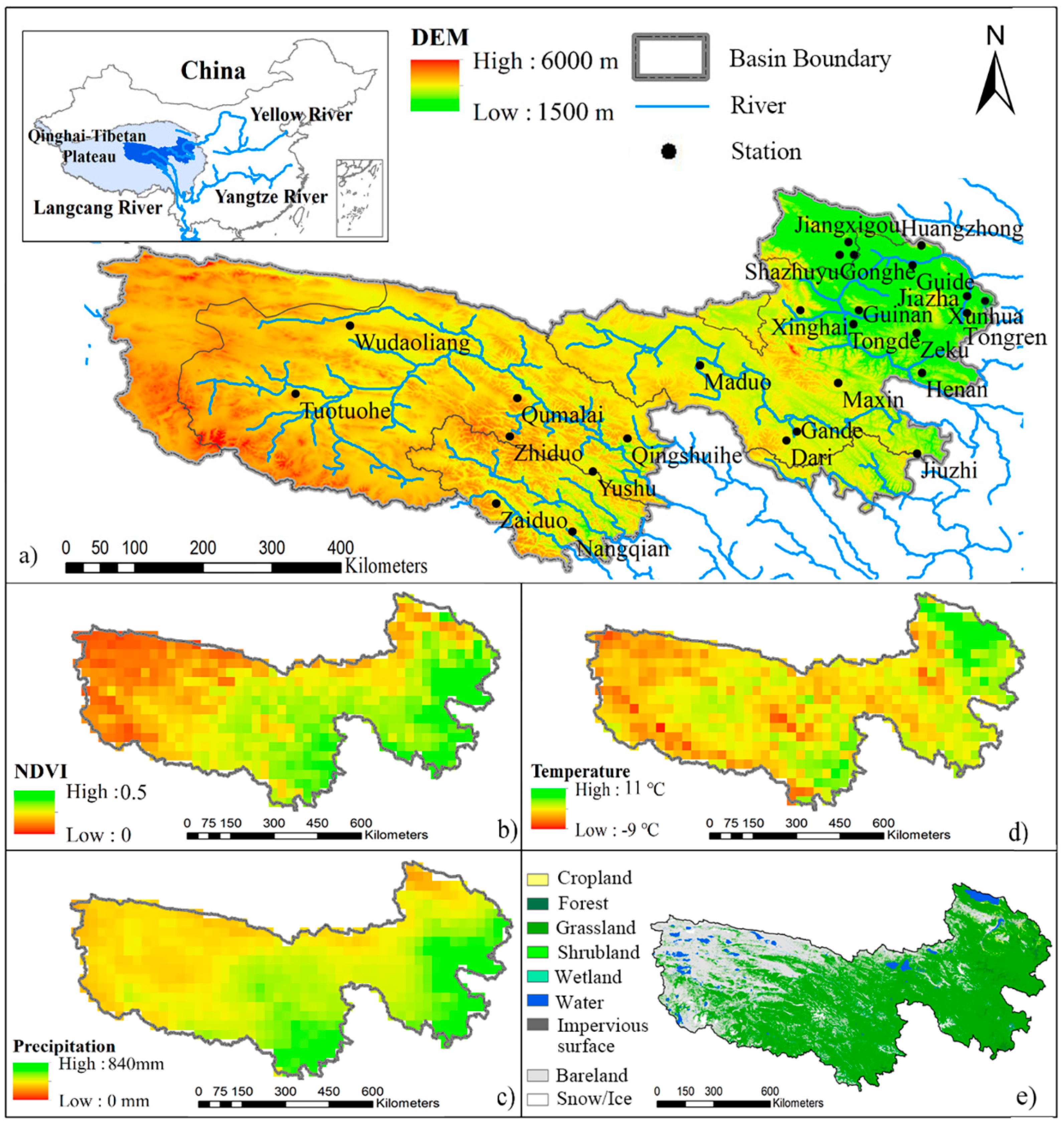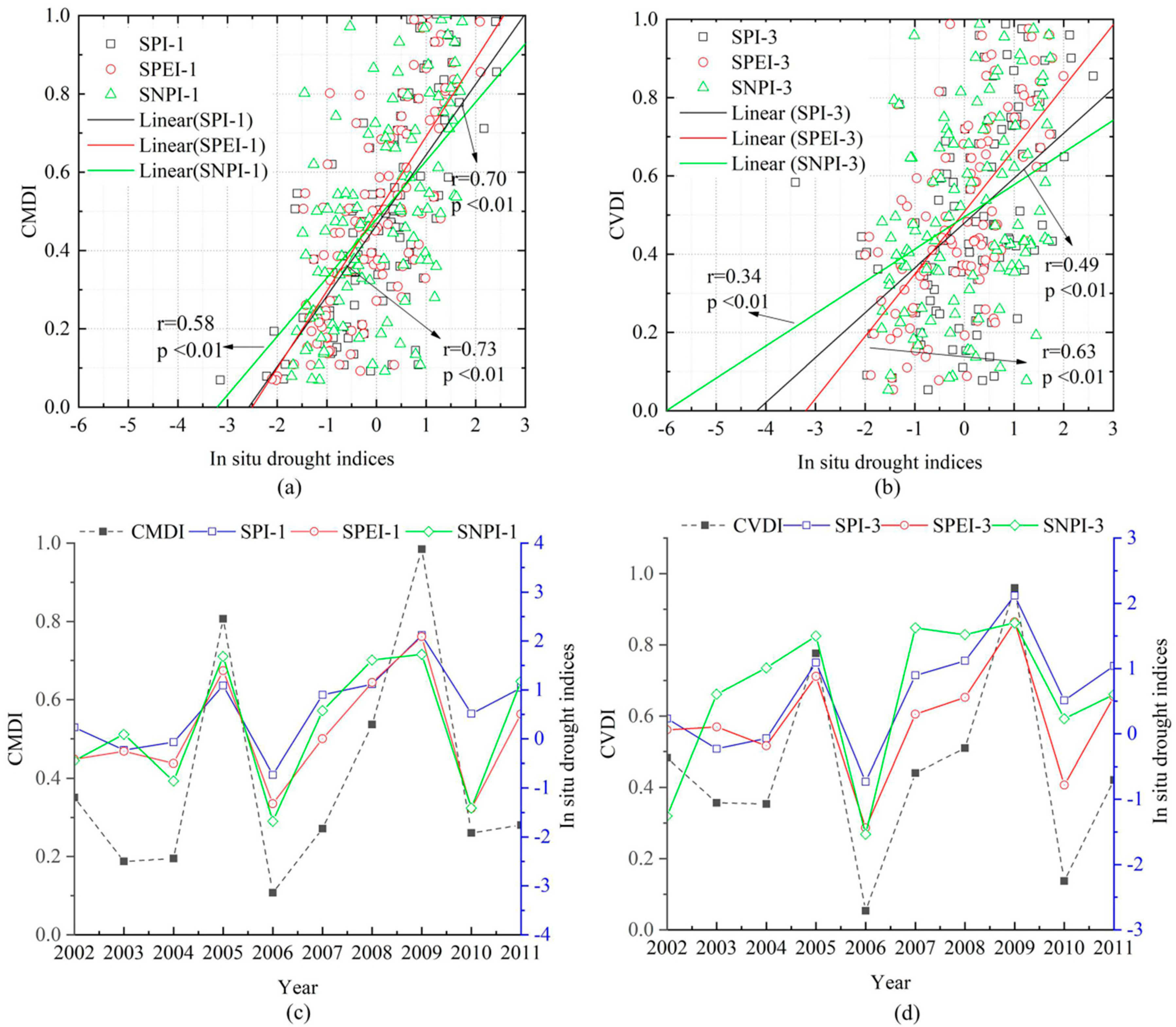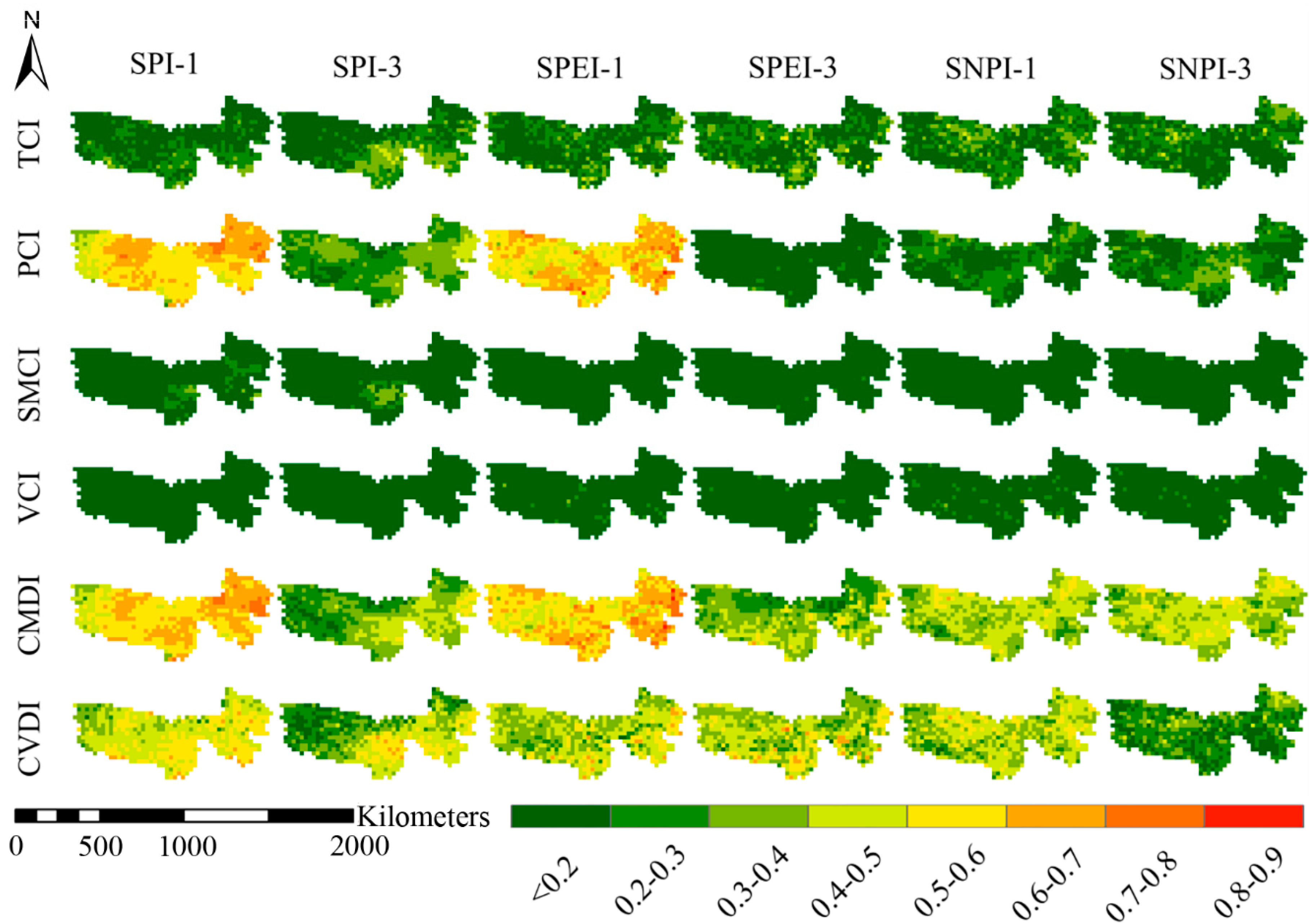Exploring Drought Conditions in the Three River Headwaters Region from 2002 to 2011 Using Multiple Drought Indices
Abstract
:1. Introduction
2. Materials and Methods
2.1. Study Area
2.2. Data
2.2.1. In Situ Reference Data
2.2.2. GIMMS AVHRR NDVI
2.2.3. CHIRPS Precipitation
2.2.4. MODLT1M Temperature
2.2.5. AMSR-E Soil Moisture
2.3. Methods
2.3.1. In Situ Drought Indices
Standardized Precipitation Index (SPI)
Standardized Precipitation Evapotranspiration Index (SPEI)
Standardized Non-Parametric Index (SNPI)
2.3.2. Single CI-Based Drought Indices
2.3.3. Combined Drought Indices
3. Results
3.1. Combined Drought Indices
3.2. Drought Patterns
3.2.1. Monthly Maps
3.2.2. Year-to Year Maps
3.3. Correlation Analysis
3.3.1. Monthly Temporal Comparisons
3.3.2. Monthly Spatial Comparisons
4. Discussion
5. Conclusions
Author Contributions
Funding
Acknowledgments
Conflicts of Interest
References
- Hagman, G. Prevention Better than Cure: Report on Human and Natural Disasters in the Third World; Swedish Red Cross: Stockholm, Sweden, 1984. [Google Scholar]
- Svoboda, M.; LeComte, D.; Hayers, M.; Heim, R.; Gleason, K.; Angel, J.; Rippey, B.; Tinker, R.; Palecki, M.; Stooksbury, D.; et al. The Drought Monitor. Bull. Am. Meteorol. Soc. 2002, 83, 1181–1190. [Google Scholar] [CrossRef]
- Huang, J.; Zhai, J.; Jiang, T.; Wang, Y.; Li, X.; Wang, R.; Xiong, M.; Su, B.; Fischer, T. Analysis of future drought characteristics in china using the regional climate model CCLM. Clim. Dyn. 2018, 50, 507. [Google Scholar] [CrossRef]
- Keyantash, J.; Dracup, J.A. The quantification of drought: An evaluation of drought indices. Bull. Am. Meteorol. Soc. 2002, 83, 1167–1180. [Google Scholar] [CrossRef]
- Mishra, A.K.; Singh, V.P. A review of drought concepts. J. Hydrol. 2010, 391, 201–206. [Google Scholar] [CrossRef]
- McKee, T.B.; Doesken, N.J.; Kleist, J. The relationship of drought frequency and duration to timescales. In Proceedings of the 8th Conference on Applied Climatology, Anaheim, CA, USA, 17–22 January 1993. [Google Scholar]
- Gu, L.; Chen, J.; Xu, C.Y.; Wang, H.M. Synthetic Impacts of Internal Climate Variability and Anthropogenic Change on Future Meteorological Droughts over China. Water 2018, 10, 1702. [Google Scholar] [CrossRef]
- Vicente-Serrano, S.M.; López-Moreno, J.I. The influence of atmospheric circulation at different spatial scales on winter drought variability through a semi-arid climatic gradient in northeast Spain. Int. J. Climatol. 2010, 26, 1427–1453. [Google Scholar] [CrossRef]
- Rao, A.R.; Voeller, T.L. Development and testing of drought indicators. Water Resour. Manag. 1997, 11, 119–136. [Google Scholar] [CrossRef]
- Zhu, Y.; Liu, Y.; Ma, X.Y.; Ren, L.L.; Singh, V.P. Drought Analysis in the Yellow River Basin Based on a Short-Scalar Palmer Drought Severity Index. Water 2018, 10, 1526. [Google Scholar] [CrossRef]
- Guttman, N.B. Accepting the standardized precipitation index: A calculation algorithm. J. Am. Water Resour. Assoc. 1999, 35, 311–322. [Google Scholar] [CrossRef]
- Zhang, A.Z.; Jia, G.S. Monitoring meteorological drought in semiarid regions using multi-input microwave remote sensing data. Remote Sens. Environ. 2013, 134, 12–23. [Google Scholar] [CrossRef]
- Zhang, L.; Jiao, W.; Zhang, H.; Huang, C.; Tong, Q. Studying drought phenomena in the continental United States in 2011 and 2012 using various drought indices. Remote Sens. Environ. 2017, 190, 96–106. [Google Scholar] [CrossRef]
- Xu, P.; Zhou, T.; Zhao, X.; Luo, H.; Gao, S.; Li, Z.; Cao, L. Diverse responses of different structured forest to drought in southwest China through remotely sensed data. Int. J. Appl. Earth Obs. 2018, 69, 217–225. [Google Scholar] [CrossRef]
- Kogan, F.N. Drought of the late 1980s in the United States as derived from NOAA polar-orbiting satellite data. Bull. Am. Meteorol. Soc. 1995, 76, 655–668. [Google Scholar] [CrossRef]
- Kogan, F.N. Application of vegetation index and brightness temperature for drought detection. Adv. Space Res. 1995, 15, 91–100. [Google Scholar] [CrossRef]
- Unganai, L.S.; Kogan, F.N. Drought monitoring and corn yield estimation in Southern Africa from AVHRR data. Remote Sens. Environ. 1998, 63, 219–232. [Google Scholar] [CrossRef]
- Peters, A.J.; Walter-Shea, E.A.; Ji, L.; Vina, A.; Hayes, M.; Svoboda, M.D. Drought monitoring with NDVI-based standardized vegetation index. Photogramm. Eng. Remote Sens. 2002, 68, 71–75. [Google Scholar]
- Wang, L.; Qu, J.J. NMDI: A normalized multi-band drought index for monitoring soil and vegetation moisture with satellite remote sensing. Geophys. Res. Lett. 2007, 34. [Google Scholar] [CrossRef] [Green Version]
- Rhee, J.Y.; Im, J.H.; Carbone, G.J. Monitoring agricultural drought for arid and humid regions using multi-sensor remote sensing data. Remote Sens. Environ. 2010, 114, 2875–2887. [Google Scholar] [CrossRef]
- Hao, C.; Zhang, J.; Yao, F. Combination of multi-input remote sensing data for drought monitoring over Southwest China. Int. J. Appl. Earth Obs. 2015, 35, 270–283. [Google Scholar] [CrossRef]
- Seiler, R.; Kogan, F.; Sullivan, J. AVHRR-based vegetation and temperature condition indices for drought detection in Argentina. Adv. Space Res. 1998, 21, 481–484. [Google Scholar] [CrossRef]
- Quiring, S.M.; Ganesh, S. Evaluating the utility of the vegetation condition index (VCI) for monitoring meteorological drought in Texas. Agric. For. Meteorol. 2010, 150, 330–339. [Google Scholar] [CrossRef]
- Zhai, J.Q.; Gao, B.; Zhu, X.Y. Fact sheet on climate disasters in China. In Annual Report on Actions to Address Climate Change; Wang, G.W., Zheng, G.G., Eds.; Social Sciences Academic Press: Beijing, China, 2014. [Google Scholar]
- Qin, D.; Zhang, J.; Shan, C.; Song, L. China National Assessment Report on Risk Management and Adaptation of Climate Extremes and Disasters; Science Press: Beijing, China, 2015; pp. 70–124. [Google Scholar]
- Zhai, J.; Huang, J.; Su, B.; Cao, L.; Wang, Y.; Jiang, T.; Fischer, T. Intensity–area–duration analysis of droughts in China 1960–2013. Clim. Dyn. 2017, 48, 151–168. [Google Scholar] [CrossRef]
- He, B.; Lü, A.; Wu, J.; Liu, M. Drought hazard assessment and spatial characteristics analysis in China. J. Geogr. Sci. 2011, 21, 235–249. [Google Scholar] [CrossRef]
- Yao, J.; Zhao, Y.; Chen, Y.; Yu, X.; Zhang, R. Multi-scale assessments of droughts: A case study in Xinjian, China. Sci. Total Environ. 2018, 630, 444–452. [Google Scholar] [CrossRef] [PubMed]
- Ren, Y.L.; Shi, Y.J.; Wang, J.S.; Li, Y.P.; Zhu, Y.J.; Yang, Z.H.; Wei, B.L. Spatial and temporal variation characteristics of drought in Northwest China during 1961–2009 with standardized precipitation index. J. Glaciol. Geocryol. 2013, 35, 938–948. [Google Scholar]
- Zhang, J.; Mu, Q.; Huang, J. Assessing the remotely sensed drought severity index for agricultural drought monitoring and impact analysis in north China. Ecol. Indic. 2016, 63, 296–309. [Google Scholar] [CrossRef]
- Zhao, S.; Cong, D.; He, K.; Yang, H.; Qin, Z. Spatial-temporal variation of drought in China from 1982 to 2010 based on a modified temperature vegetation drought index (mTVDI). Sci. Rep. 2017, 7, 17473. [Google Scholar] [CrossRef]
- Liu, R.R.; Lu, B.H.; Chen, Y.T.; Dong, C.; Ruan, X.B.; Tang, W.T. Analysis on features of dry climate in the Three-Rivers Headwaters based on palmer drought severity index. Yellow River 2013, 35, 59–62. (In Chinese) [Google Scholar]
- Bai, X.L.; Wei, J.H.; Xie, H.W. Characteristics of wetness/dryness variation and their influences in the Three-River Headwaters region. Acta Geol. Sin. 2017, 37, 8397–8410. (In Chinese) [Google Scholar]
- Zeng, H.W.; Li, L.J. Accuracy validation of TRMM 3B43 data in Lancang river basin. Acta Geol. Sin. 2011, 66, 994–1004. (In Chinese) [Google Scholar]
- Gao, W.; An, R.; Wang, Z. Drought Index and Its Application Based on Microwave Remote Sensing Technology: A Case Study in the Three-River Headwaters Region. Arid Zone Res. 2017, 34, 541–550. (In Chinese) [Google Scholar]
- Dai, S.; Li, L.; Wang, Z.Y. The diagnosis analysis of exceptional drought Three-River Headwaters Region in the summer of 2006. J. Qinghai Meteorol. 2007, 3, 39–42. (In Chinese) [Google Scholar]
- Yi, X.S.; Yin, Y.Y.; Li, G.S.; Peng, J.T. Temperature Variation in Recent 50 Years in the Three-River Headwaters Region of Qinghai Province. Acta Geol. Sin. 2011, 66, 1451–1465. (In Chinese) [Google Scholar]
- Rouse, J., Jr.; Haas, R.; Schell, J.; Deering, D. Monitoring vegetation systems in the Great Plains with ERTS. NASA Spec. Publ. 1974, 1, 309–317. [Google Scholar]
- National Meteorological Information Center Home Page. Available online: http://data.cma.cn/data/cdcdetail/dataCode/SURF_CLI_CHN_PRE_MON_GRID_0.5.html (accessed on 1 September 2018). (In Chinese).
- National Meteorological Information Center Home Page. Available online: http://data.cma.cn/data/cdcdetail/dataCode/SURF_CLI_CHN_TEM_MON_GRID_0.5.html (accessed on 1 September 2018). (In Chinese).
- Gong, P.; Wang, J.; Yu, L.; Zhao, Y.; Zhao, Y.; Liang, L.; Niu, Z.; Huang, X.; Fu, H.; Liu, S.; et al. Finer resolution observation and monitoring of global land cover: First mapping results with Landsat TM and ETM+ data. Int. J. Remote Sens. 2013, 34, 2607–2654. [Google Scholar] [CrossRef]
- Yu, L.; Wang, J.; Gong, P. Improving 30m global land-cover map from-GLC with time series Modis and auxiliary data sets: A segmentation-based approach. Int. J. Remote Sens. 2013, 34, 5851–5867. [Google Scholar] [CrossRef]
- Finer Resolution Observation and Monitoring—Global Land Cover Home Page. Available online: http://data.ess.tsinghua.edu.cn/fromglc2017v1.html (accessed on 24 December 2018).
- Zheng, Y.T.; Huang, Y.F.; Wang, K.Y. Response of Vegetation to Water Stress in the Three River Headwaters Region of China. J. Basic Sci. Eng. 2018, 26, 249–262. (In Chinese) [Google Scholar]
- Wu, X.; Wang, Z.; Zhou, X.; Lai, C.; Lin, W.; Chen, X. Observed changes in precipitation extremes across 11 basins in China during 1961–2013. Int. J. Climatol. 2016, 36, 2866–2885. [Google Scholar] [CrossRef]
- Dong, L.; Zhang, M.J.; Wang, S.J.; Zhu, X.F.; Ren, Z.G.; Wang, Q. Extreme precipitation events in arid areas in Northwest China based on gridded data. J. Nat. Resour. 2014, 29, 2048–2057. (In Chinese) [Google Scholar]
- Shi, J.; Reichenbach, S.E. Image interpolation by two-dimensional parametric cubic convolution. IEEE Trans. Image Process. 2006, 15, 1857–1870. [Google Scholar] [Green Version]
- Shi, H.; Li, T.; Wei, J.H. Evaluation of the gridded CRU ts precipitation dataset with the point rain gauge records over the Three River Headwaters Region. J. Hydrol. 2017, 548, 322–332. [Google Scholar] [CrossRef]
- NASA Earth Exchange Home Page. Available online: https://nex.nasa.gov/nex/ (accessed on 10 October 2018).
- Simoniello, T. On the relevance of accurate correction and validation procedures in the analysis of AVHRR-NDVI time series for long-term monitoring. J. Geophys. Res. Atmos. 2004, 109, D20107. [Google Scholar] [CrossRef]
- Climate Hazards Group Home Page. Available online: http://chg.geog.ucsb.edu/index.html (accessed on 10 October 2018).
- Moderate Resolution Imaging Spectroradiometer Home Page. Available online: https://modis.gsfc.nasa.gov/data/dataprod/mod11.php (accessed on 10 October 2018).
- Geospatial Date Cloud Home Page. Available online: http://www.gscloud.cn/ (accessed on 10 October 2018).
- Rouault, M.; Richard, Y. Intensity and spatial extent of droughts in southern Africa. Geophys. Res. Lett. 2005, 32, L15702. [Google Scholar] [CrossRef]
- Niu, J.; Chen, J.; Sun, L. Exploration of drought evolution using numerical simulations over the Xijiang (West River) basin in south china. J. Hydrol. 2015, 526, 68–77. [Google Scholar] [CrossRef]
- Allen, R.G.; Pereira, L.S.; Raes, D. M Smith Crop Evapotranspiration: Guidelines for Computing Crop Requirements; Irrigation and Drainage Paper 56; FAO: Roma, Italy, 1998. [Google Scholar]
- Droogers, P.; Allen, R.G. Estimating reference evapotranspiration under inaccurate data conditions. Irrig. Drain. Syst. 2002, 16, 33–45. [Google Scholar] [CrossRef]
- Mavromatis, T. Drought index evaluation for assessing future wheat production in Greece. Int. J. Climatol. 2007, 27, 911–924. [Google Scholar] [CrossRef] [Green Version]
- Thornthwaite, C.W. An approach toward a rational classification of climate. Geogr. Rev. 1948, 38, 55–94. [Google Scholar] [CrossRef]
- Vicente-Serrano, S.M.; Beguería, S.; López-Moreno, J.I. A multi-scala drought index sensitive to global warming: The standardized precipitation evapotranspiration index—SPEI. J. Clim. 2012, 23, 1696–1718. [Google Scholar] [CrossRef]
- Onyutha, C. On Rigorous Drought Assessment Using Daily Time Scale: Non-Stationary Frequency Analyses, Revisited Concepts, and a New Method to Yield Non-Parametric Indices. Hydrology 2017, 4, 48. [Google Scholar] [CrossRef]
- Jain, S.K.; Keshri, R.; Goswami, A.; Sarkar, A.; Chaudhry, A. Identification of drought-vulnerable areas using NOAA AVHRR data. Int. J. Remote Sens. 2009, 30, 2653–2668. [Google Scholar] [CrossRef]
- Brown, J.F.; Wardlow, B.D.; Tadesse, T.; Hayes, M.J.; Reed, B.C. The Vegetation Drought Response Index (VegDRI): A new integrated approach for monitoring drought stress in vegetation. GISci. Remote Sens. 2008, 45, 16–46. [Google Scholar] [CrossRef]
- Jiao, W.; Zhang, L.; Chang, Q.; Fu, D.; Cen, Y.; Tong, Q. Evaluating an enhanced vegetation condition index (VCI) based on VIUPD for drought monitoring in the continental United States. Remote Sens. 2016, 8, 224. [Google Scholar] [CrossRef]
- Bhuiyan, C.; Singh, R.P.; Kogan, F.N. Monitoring drought dynamics in the Aravalli region (India) using different indices based on ground and remote sensing data. Int. J. Appl. Earth Obs. 2006, 8, 289–302. [Google Scholar] [CrossRef]







| Station Name | Longitude (° E) | Latitude (° N) | Elevation (m) |
|---|---|---|---|
| Jiangxigou | 100.29 | 36.35 | 3201 |
| Gonghe | 100.37 | 36.16 | 2835 |
| Guide | 101.22 | 36.01 | 2237 |
| Huangzhong | 101.35 | 36.3 | 2668 |
| Wudaoliang | 93.05 | 35.13 | 4612 |
| Shazhuyu | 100.16 | 36.16 | 2872 |
| Xinghai | 99.59 | 35.35 | 3323 |
| Guinan | 100.44 | 35.35 | 3120 |
| Tongde | 100.36 | 35.15 | 3148 |
| Jianzha | 102.01 | 35.56 | 2086 |
| Zeku | 101.28 | 35.02 | 3663 |
| Xunhua | 102.27 | 35.51 | 1921 |
| Tongren | 102.01 | 35.31 | 2491 |
| Tuotuohe | 92.26 | 34.13 | 4533 |
| Zhiduo | 95.37 | 33.51 | 4179 |
| Zaiduo | 95.17 | 32.53 | 4066 |
| Qumalai | 95.48 | 34.07 | 4175 |
| Yushu | 96.58 | 33.00 | 3717 |
| Maduo | 98.13 | 34.55 | 4272 |
| Qingshuihe | 97.08 | 33.48 | 4415 |
| Maxin | 100.14 | 34.29 | 3719 |
| Gande | 99.54 | 33.58 | 4050 |
| Dari | 99.39 | 33.45 | 3968 |
| Henan | 101.36 | 34.44 | 3500 |
| Jiuzhi | 101.29 | 33.26 | 3629 |
| Nangqian | 96.28 | 32.12 | 3644 |
| Index | Percent | SPI-1 | SPI-3 | SPI-6 | SPEI-1 | SPEI-3 | SPEI-6 | SPNI-1 | SNPI-3 | SNPI-6 | |||
|---|---|---|---|---|---|---|---|---|---|---|---|---|---|
| TCI | PCI | SMCI | VCI | ||||||||||
| CMDI | 29.00% | 64.00% | 7.00% | - | 0.70 | 0.44 | 0.32 | 0.73 | 0.53 | 0.31 | 0.58 | 0.32 | 0.31 |
| CVDI | 65.00% | 26.00% | 6.00% | 4.00% | 0.57 | 0.49 | 0.34 | 0.65 | 0.63 | 0.40 | 0.56 | 0.34 | 0.32 |
| Name | PCI | TCI | SMCI | VCI | CMDI | CVDI |
|---|---|---|---|---|---|---|
| Extreme drought | 0–0.1 | 0–0.1 | 0–0.1 | 0–0.1 | 0–0.1 | 0–0.1 |
| Severe drought | 0.1–0.2 | 0.1–0.2 | 0.1–0.2 | 0.1–0.2 | 0.1–0.2 | 0.1–0.2 |
| Moderate drought | 0.2–0.3 | 0.2–0.3 | 0.2–0.3 | 0.2–0.3 | 0.2–0.3 | 0.2–0.3 |
| Mild drought | 0.3–0.4 | 0.3–0.4 | 0.3–0.4 | 0.3–0.4 | 0.3–0.4 | 0.3–0.4 |
| Abnormally dry | 0.4–0.5 | 0.4–0.5 | 0.4–0.5 | 0.4–0.5 | 0.4–0.5 | 0.4–0.5 |
| No drought | 0.5–1 | 0.5–1 | 0.5–1 | 0.5–1 | 0.5–1 | 0.5–1 |
© 2019 by the authors. Licensee MDPI, Basel, Switzerland. This article is an open access article distributed under the terms and conditions of the Creative Commons Attribution (CC BY) license (http://creativecommons.org/licenses/by/4.0/).
Share and Cite
Wang, K.; Li, T.; Wei, J. Exploring Drought Conditions in the Three River Headwaters Region from 2002 to 2011 Using Multiple Drought Indices. Water 2019, 11, 190. https://doi.org/10.3390/w11020190
Wang K, Li T, Wei J. Exploring Drought Conditions in the Three River Headwaters Region from 2002 to 2011 Using Multiple Drought Indices. Water. 2019; 11(2):190. https://doi.org/10.3390/w11020190
Chicago/Turabian StyleWang, Keyi, Tiejian Li, and Jiahua Wei. 2019. "Exploring Drought Conditions in the Three River Headwaters Region from 2002 to 2011 Using Multiple Drought Indices" Water 11, no. 2: 190. https://doi.org/10.3390/w11020190
APA StyleWang, K., Li, T., & Wei, J. (2019). Exploring Drought Conditions in the Three River Headwaters Region from 2002 to 2011 Using Multiple Drought Indices. Water, 11(2), 190. https://doi.org/10.3390/w11020190







